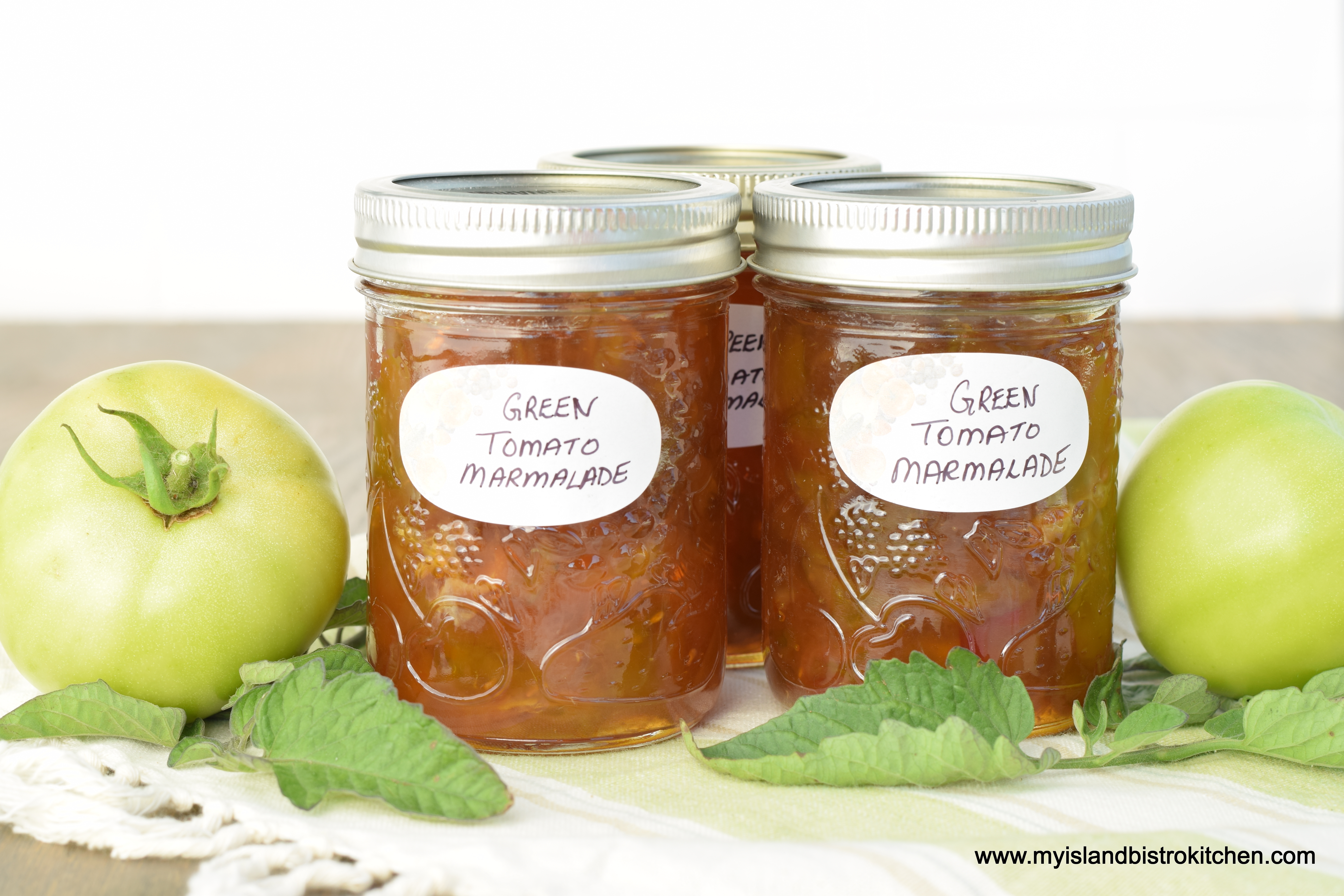
Green Tomato Marmalade is not an altogether common variety of marmalade. It’s not a typical marmalade likely to be found on many, if any, supermarket shelves. That, in my view, makes Green Tomato Marmalade all the more special because it’s more unique and exclusive! That, plus the fact it can be used as either a sweet or savory spread, makes this marmalade a worthwhile addition to your preserve inventory.
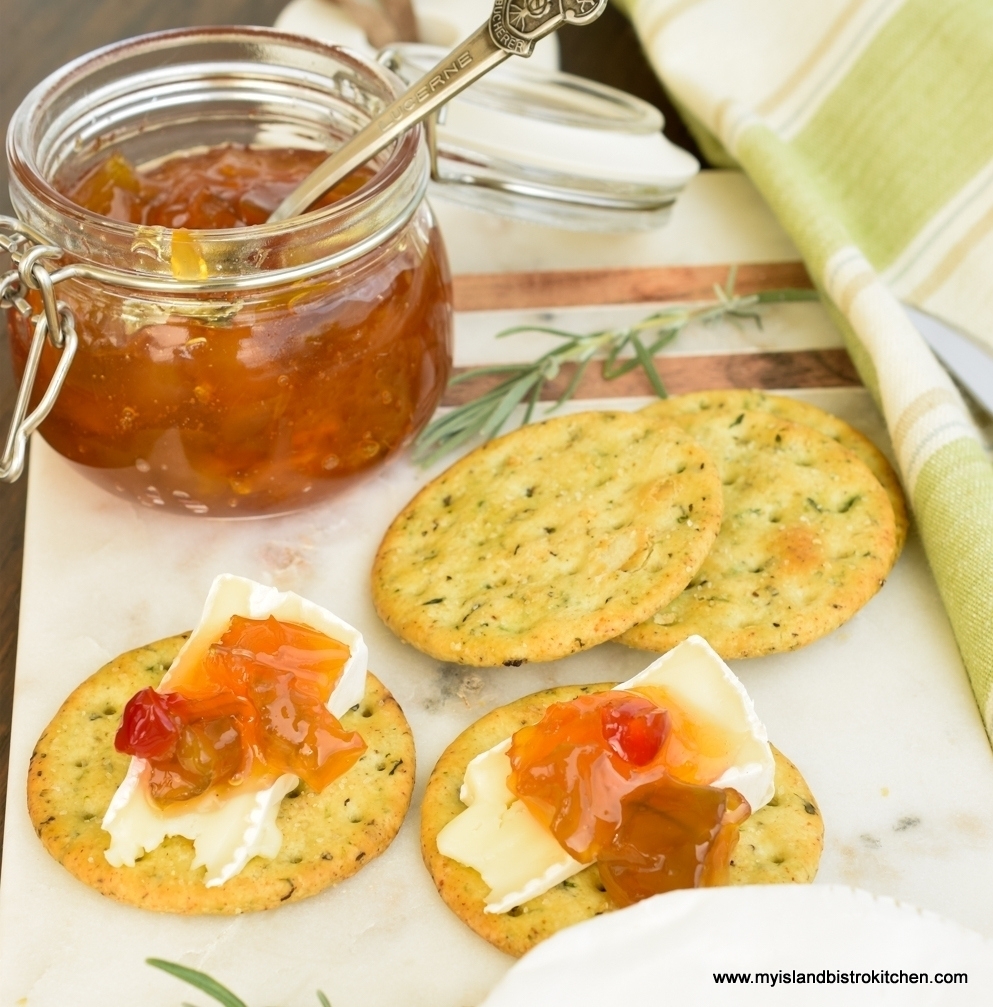
Green Tomato Marmalade is a great way to make use of the usual abundance of green tomatoes many gardeners end up with in their gardens in late summer or early fall and are wondering what they can do with them so they aren’t wasted.
Variations of green tomato jam and marmalade have been around for years. I expect many homemakers of years ago made one or the other because they would have likely had lots of tomatoes in the garden so it was an economical ingredient to use and to have as a spread for bread, toast, or biscuits over the winter. Those homemakers were frugal and resourceful by necessity as there were no big supermarkets with the large selection of jams and marmalades we see today and, in some cases, families were large and did not have a lot of money. So, consequently, they figured out ways to feed their families economically, making good use of food they grew themselves.
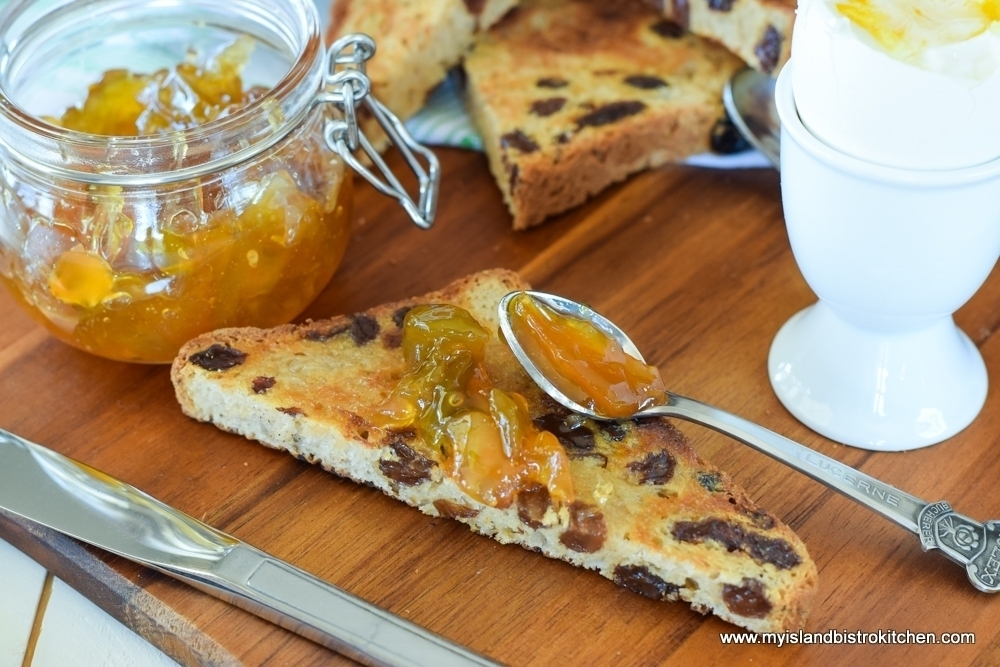
Green Tomato Marmalade is one of those food items I would class as “don’t knock it till you’ve tried it”. This marmalade is both sweet and savory, making it a versatile product to have on the pantry shelf. Combining the green tomatoes with citrus flavours (orange and lemon) and some crushed pineapple for sweetness balance and texture, this marmalade is versatile and can be used just as one would use orange marmalade, for example – spread on toast, biscuits, and scones. Green Tomato Marmalade can also be eaten as a savory condiment with cheese, charcuterie, and crackers.

Almost any variety of medium/large tomatoes can be used for this marmalade. My advice would be to try to find a variety that does not have a lot of seeds as the tomatoes will yield more tomato meat per pound for the marmalade and the tomatoes will be a lot easier to prepare This is because the seeds and the watery/gelatinous sack that are inside the tomatoes need to be removed for this marmalade. Leaving them in will result in two things: 1) Too much water in the marmalade potentially causing issues getting it to gel; and 2) a marmalade with too many seeds in it. Many varieties of tomatoes, by nature, are tremendously seedy and all those seeds just simply do not look appetizing in the finished product and are a nightmare for anyone who cannot digest seeds well. The odd few seeds may make their way in to the marmalade and are not, generally, a problem for most but the intent is to remove as many seeds as possible from the tomatoes.
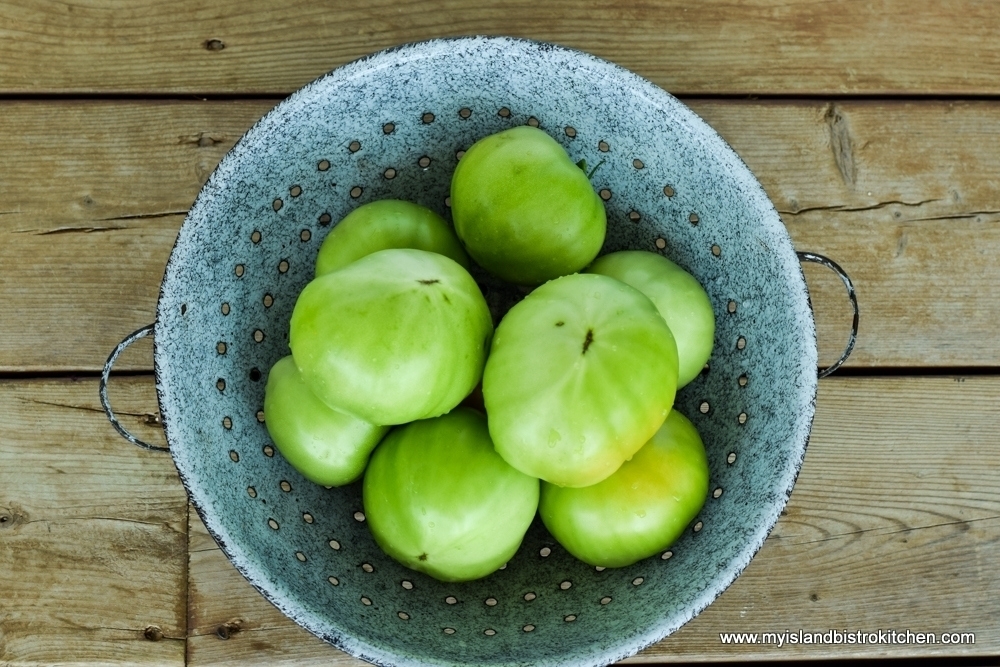
Cut each tomato in half, then each half into several wedges.
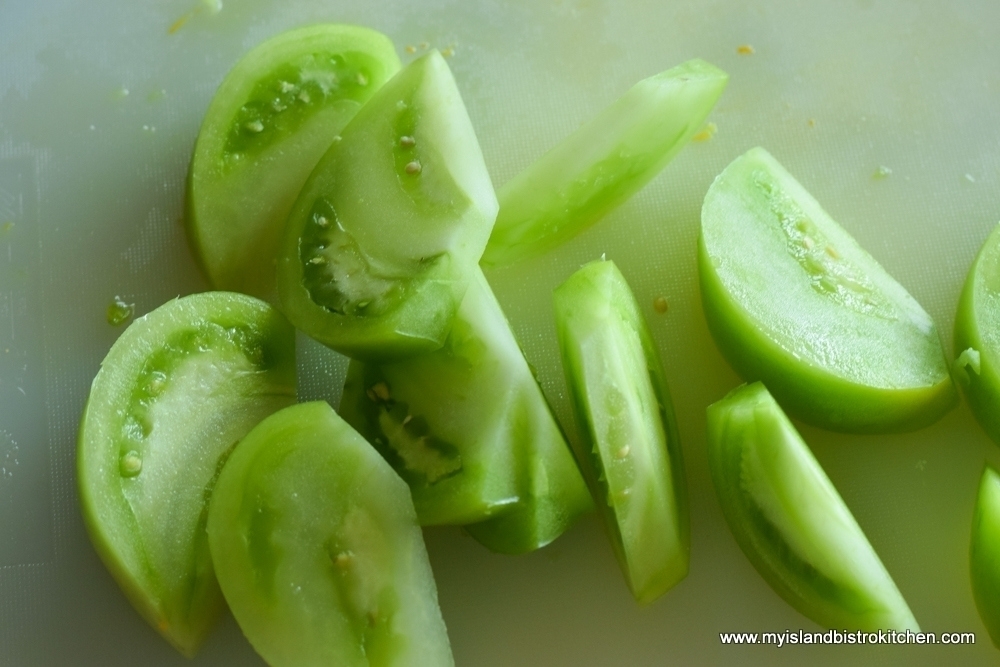
Scoop, or cut, out and discard the watery gelatinous sack and its seeds.
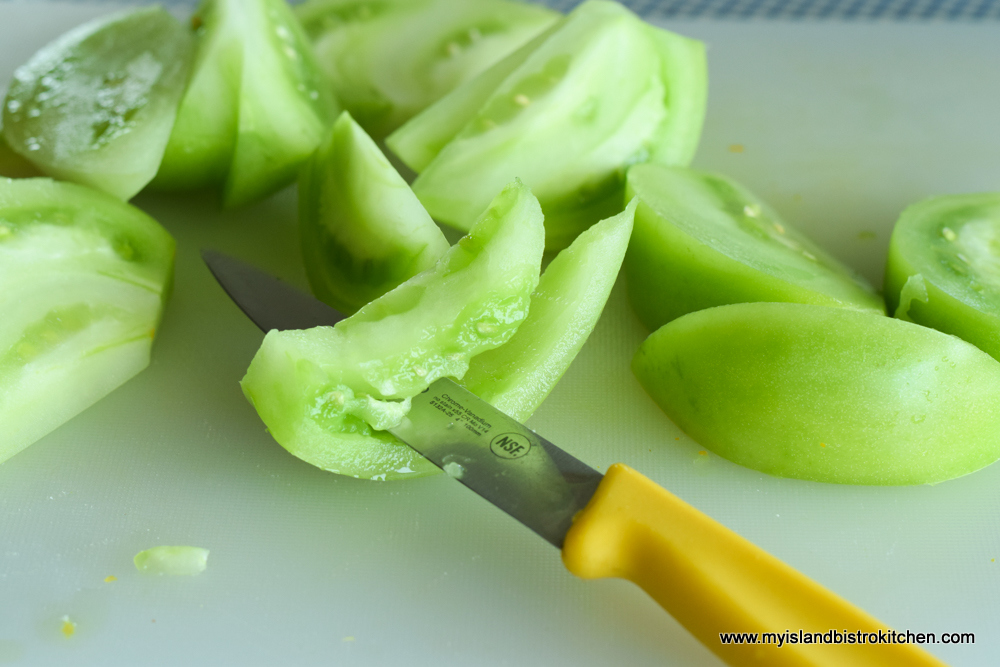
Cut up the remaining tomato pieces into small, bite-sized chunks. These don’t need to be minced, by any means, but they need to be small enough to get cooked properly and to look appealing when spread on toast or biscuits.
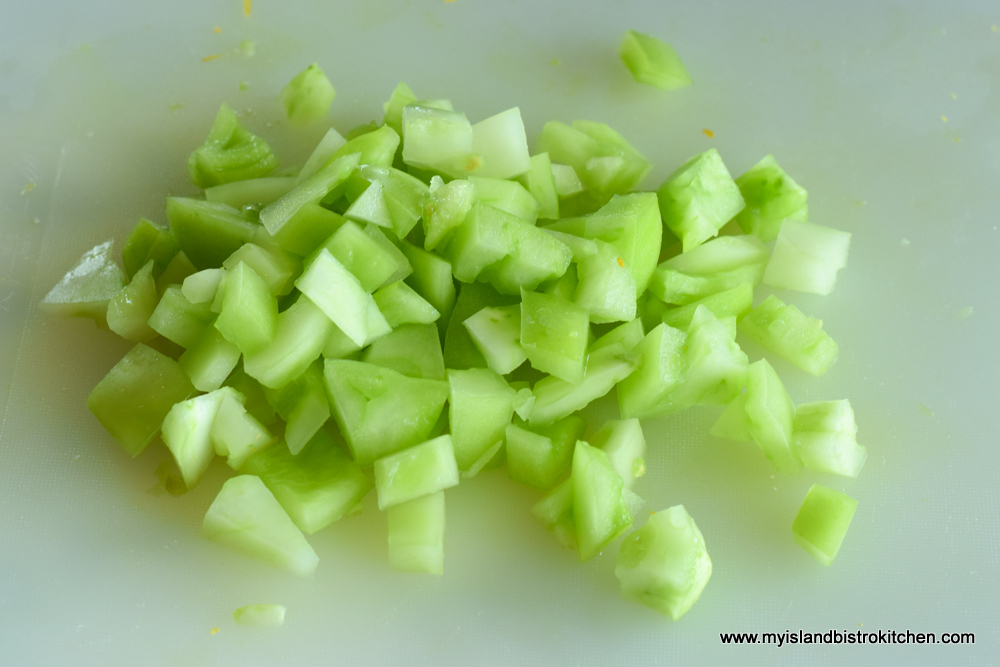
The addition of lemon and orange (and their zests) is what, in my opinion, makes this a marmalade as marmalades traditionally contain citrus fruit. This recipe calls for a small amount of crushed pineapple. This adds an element of sweetness, flavour, and texture. There is no need to thoroughly drain the pineapple in a sieve or colander but, instead, use a slotted spoon to scoop the pineapple out of the can and let most of the juice drip off for a few seconds before measuring the pineapple. There will still be juice in the pineapple and up to a couple of tablespoons (no more) of the juice will be fine. Any more and, like the watery part of tomatoes, it would add too much liquid to the marmalade content, potentially causing issues getting it to gel.
Adding a small piece of cinnamon stick injects a subtle hint of cinnamon to the marmalade. However, it is not recommended to leave the cinnamon stick in the marmalade for the entire cooking process because it can result in too intense and excessive cinnamon flavour which is not the intent with this marmalade. I suggest removing the cinnamon stick piece after about an hour or so of cooking.
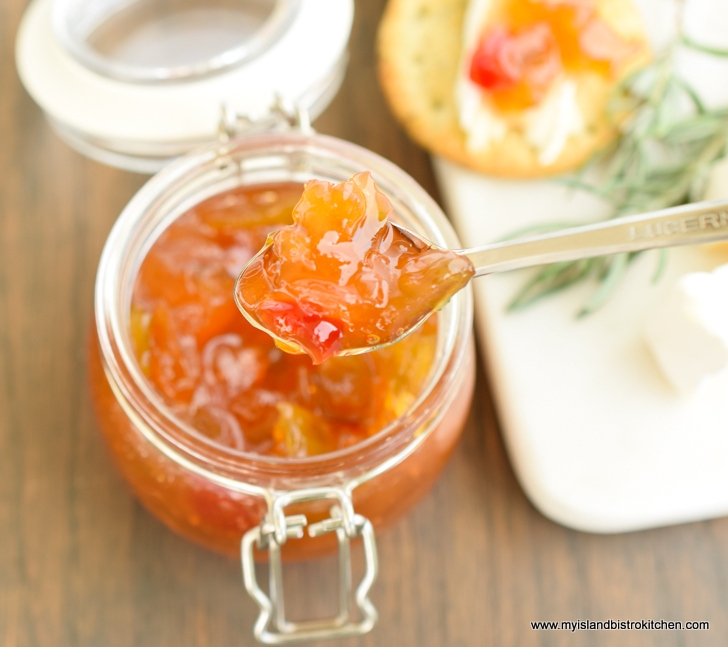
Care must be taken to ensure the marmalade does not scorch as it slowly cooks. With the sugar content, scorching is always a risk. Once a jam or marmalade has scorched, there is no fixing it and it’s a batch destined for the green compost cart. Stirring the marmalade fairly regularly as it cooks will help it to thicken and prevent scorching (as will keeping it at a low boil and using a heavy bottomed stock pot). It’s all about heat control. If desired, a few cut up drained red maraschino cherries can be added for color at the end of the cooking process.
Patience is required to make marmalade – it takes time for it to set and it takes the time it takes. Don’t try to hurry the process along by boiling the marmalade mixture faster.
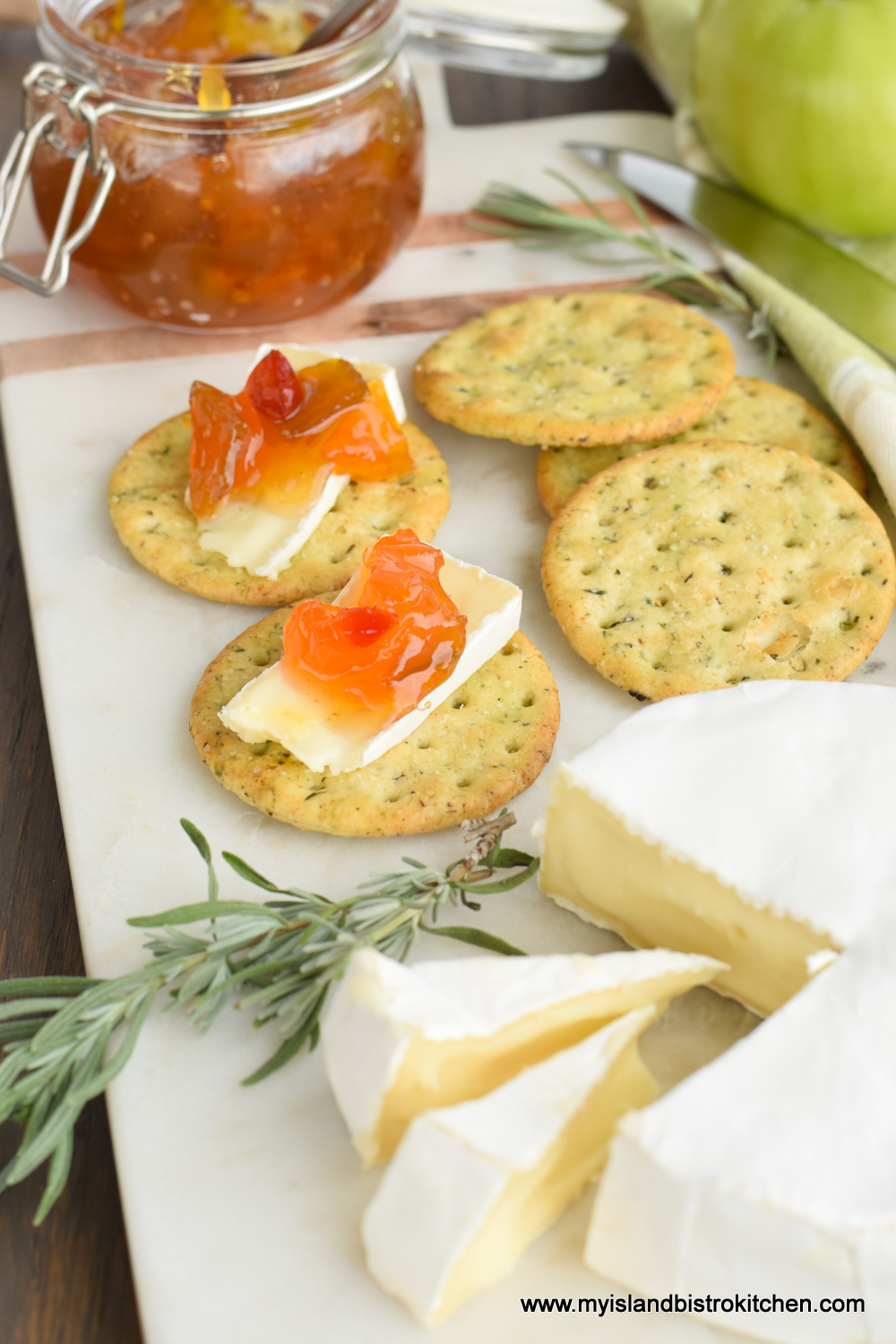
The lemons, orange, and crushed pineapple turn the bright green tomatoes into a superb marmalade of glorious golden amber color. Don’t expect this marmalade to taste like tomatoes as might be expected. Rather, it has a surprisingly sweet and savory blend of flavours that make it a tasty and luxurious marmalade for which a multitude of creative uses can be found.
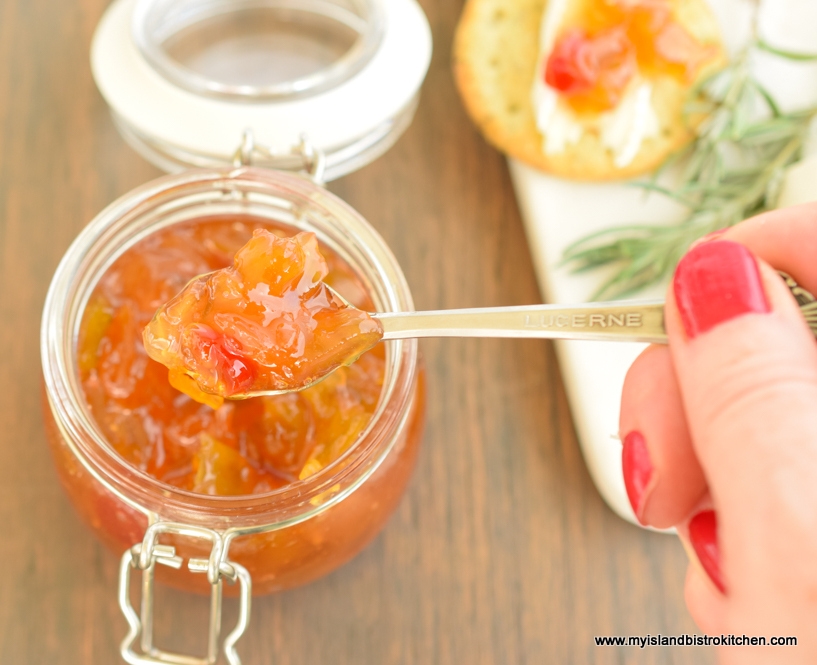
Give it a try but, first, be sure to read the following tips on making marmalade.
TIPS FOR SUCCESSFUL
MARMALADE MAKING
Get Organized
Marmalade making, like any jam or jelly making, is a sequential process and it pays to take the time to get organized for the task. The first step is to read and re-read the recipe to ensure complete understanding of the process and that you have all the necessary ingredients and equipment.
The second step in organization is to assemble all equipment and ingredients needed for the marmalade-making and canning processes. A list of equipment and utensils needed to make the marmalade can be found further down in this post.
The third step is to start the bottle sterilization process before beginning to make the marmalade as the sterilized bottles must be ready when the marmalade is finished cooking. Cooking the marmalade takes some attention and stirring so it’s best if the bottle sterilization process is begun before the process of cooking the marmalade begins.
Set the hot water canner out and, when the marmalade has been cooking for about 20-30 minutes, fill the canner about one-half full of hot tap water and bring it to a boil over medium-high heat. Immediately reduce the heat to keep the water hot and ready for when the jars have been filled with marmalade for hot water processing.
Follow the Recipe Exactly – No Substituting, Omitting, or Altering of Ingredient Amounts
For success, follow the recipe exactly, without substituting, omitting, or altering amounts of ingredients (unless, of course, an ingredient is listed as “optional”). Each ingredient contributes something valuable to the finished product. For example, it is well-known that jam and marmalade recipes call for a lot of sugar. Some will ask if they can significantly reduce the amount of sugar called for in a recipe and the simple answer is, no, not without potentially affecting the gelling properties of the end product and sacrificing the quality and preservative functions of the jam or marmalade. Apart from the sweetness sugar imparts on jam and marmalade, it also acts as a preservative, protecting the product against the development of bacteria, yeast, and mold. It is, along with the hot water processing of the jam or marmalade, what will make the jam/marmalade shelf stable for several months.
Use Only Proper Canning Jars for Marmalade
Ensure that proper canning jars, approved for hot water processing, are used for the marmalade. These are bottles under labels such as Mason or Ball brand jars that are made of specially tempered glass capable of withstanding heat that will be necessary in the hot water canner for safe home canning of products. The glass jars have a wide mouth top and consist of a two-part lid and screw/ring band. Exercise caution purchasing jars, that look very much like canning jars, at places like discount stores or thrift/second hand shops as they may not, in fact, be tempered glass suitable for canning.
While our ancestors may have used just any old bottles they had at their disposal, using recycled bottles from store-bought products like pasta sauce or pickles, for example, is not recommended for food safe home canning. First, these jars, having already been sealed by the manufacturer and the seals having been broken by the consumer to reveal the jar contents, no longer have proper sealing covers considered safe for home canning of products. Second, the bottles are generally made of glass not as thick as proper canning jars and, therefore, are not considered to be resistant to heat extremes. This means they could shatter or explode when placed in the hot water canner.
With the potential for so many air- and food-borne illnesses to occur today and with the changing conditions in which our foods are grown (or modified), along with the fact that most homes today do not have dedicated temperature-controlled cold rooms (or cold cellars like many of our ancestors had) in which to store home canned goods, it is all the more reason why both the proper canning jars and home canning procedures are an essential component to marmalade making. Do not skip the proper bottle sterilization and hot water canning processes.
Sterilizing the Jars
I use the traditional method of sterilizing the jars in hot water as I find it gives me good control over the timing of having the hot jars ready at the express moment the marmalade is ready for bottling. The jars must be hot when they are filled with the marmalade as they will be immediately going into the hot water canner of boiling water and cold jars subjected to this are likely to crack.
Approximately six (6) half-pint sized glass canning jars will be required for this recipe. Begin by inspecting each jar before using it to ensure there are no chips or cracks.
Because the sterilized jars must be ready at the moment the marmalade is cooked, you will want to get the jar sterilization process underway before you start cooking the marmalade as it takes time to get a big pot of water to the boiling point and the marmalade will need your attention while it is cooking.
Wash the jars in hot soapy water. Rinse well and drain jars. Fill a large-sized pot (fitted with a wire rack to keep the jars up off the bottom of the pot), capable of holding at least 7-8 half-pint jars upright, about two-thirds full of hot tap water. Use two large pots for this process, if necessary. Do not stack jars, one on top of another, as they will click together when the water is boiling and potentially crack.
Place the jars, upright and in single layer, into the water. Placing the jars upright for sterilization also makes it easy to grasp the jars with the jar lifter tongs to remove them from the water when it comes time to bottle the marmalade. Ensure the jars are fully submerged, each jar filled with water, and that the water is at least an inch over the tops of the jars, adding more if necessary. Cover, bring to a boil, and boil gently for 10 minutes. Turn off heat and leave the jars in the hot water to have ready to fill once the marmalade is ready.
Because so many factors can determine exactly how many jars will be needed to accommodate the marmalade, I recommend having at least 2-3 extra jars sanitized in case they are needed. Even if they aren’t needed to be filled with marmalade, the hot empty jars may be needed to fill up space in the hot water canner if it is not completely filled to capacity with jars containing the marmalade. This is to ensure that the filled jars do not topple over during the hot water processing.
To protect your countertop from the hot wet bottles and marmalade drippings, use a heatproof cutting board covered with newspaper to protect the board while the jars are being filled with the marmalade. Set a wire rack on top of the board and set the hot drained jars upright on the rack.
Lids and Screw Bands/Rings
The flat metal lids for the canning jars are only single use and are NEVER to be reused for canning food. Always, always use new lids for each canning session. The lids are inexpensive so don’t risk re-using them. Once you finish a bottle of marmalade, turf the lid.
While, historically, the lids (with the orange-rust colored gasket on their underside) were preheated in simmering hot water for 1-2 minutes to soften the lid gasket before applying the lids to the hot jars, Bernardin® (the company that manufactures canning lids available here in Canada) is now saying that preheating their own particular brand of lids is no longer necessary to provide a proper seal as the sealing compound they use in their lid manufacturing performs better at room temperature. They recommend washing the lids in hot soapy water, rinsing them, and setting the lids aside until needed in the canning process.
Note this pertains specifically to the Bernardin® brand of lids. Other manufacturers’ lids may differ so, if you are using another brand of lids, do check the manufacturer’s instructions with respect to heating lids, or not, for their particular brand lids. Typically, if the lids need to be preheated, the method is simply to place the lids in a small pan of simmering hot water over low heat just long enough to heat the rubber piece. This won’t take longer than a minute or two at most. Do not boil the lids.
The screw bands (aka rings) can be re-used so long as they don’t have any rust spots on them or any dents.
Cooking the Marmalade to the “Set” Stage
Marmalade typically sets at between 217°F and 220°F. At 217°F, the marmalade will be a bit more pliable than at 220°F when it will have a slightly firmer consistency/texture. The temperature at which the marmalade is taken off the stove will determine how runny or thick it is. Undercooking the marmalade will result in a very runny product while overcooking it will make it too thick and sticky to spread on anything and it will become very dark in color, losing its lovely amber color.
I tend to boil my marmalade slowly until it reaches 220°F. I find, at that stage, the marmalade has a lovely thick, yet still spreadable consistence. Marmalade is meant to be thicker than jam but still needs to be spreadable. A candy thermometer or instant read thermometer is needed for taking the marmalade’s temperature and is a more certain way to know when the marmalade has reached the setting stage.
However, if you don’t have either type of thermometer, there is an alternate way to determine marmalade doneness and that is using what is known as the “chill test”.
To conduct this test, place 2-3 freezer-safe saucers in the freezer before starting to cook the marmalade. Somewhere around the 45-50 minutes of cooking, remove a small amount of the marmalade and place it on a chilled saucer and swirl the saucer around. Let marmalade sit, untouched, for about a minute, then gently push your finger through the marmalade. If the marmalade holds its shape (i.e., does not run back together after the finger has been removed from the marmalade), it is set and ready to bottle. If it does not hold its shape, continue to cook mixture, repeating the “chill” test about every 3 minutes or so (always removing the pot from the heat while conducting the chill test) until the marmalade passes the “chill” test. Do not overcook as it will result in a very thick marmalade, dark in color.
Filling the Jars with Marmalade
When the marmalade is ready to be bottled, use a jar lifter to remove the hot sanitized jars from the water and carefully empty out the hot water back into the stock pot. Drain jars well and transfer them to the wire rack on the heatproof board. Do be very careful as this is scalding hot water.
Use a heatproof glass measuring cup or ladle to scoop up the marmalade and transfer it into the hot sterilized jars. A wide-mouthed funnel is useful for this process. Fill the jars, leaving about ¼″ headroom in each.
Remove any air bubbles that may appear in the jars by inserting a chopstick or small heat-proof spatula into each bottle and gently moving the marmalade to remove any pockets of air that may have formed. Add more marmalade, if necessary, to bring the marmalade up to about ¼“ from jar rim.
Make sure the rims of the filled jars have been wiped with a damp clean cloth to remove any marmalade residue. Even a small drop of it may prevent the lids from sealing properly and keeping out harmful bacteria that could cause the marmalade to spoil or someone to become ill from consuming it.
Center the washed and rinsed room temperature lids on jars so the sealing compound on the lid edges aligns with the jar rims. Once the jars have been filled with marmalade, fingertip tighten ring/screw bands on jars until resistance is encountered. Do not over-tighten.
Hot Water Processing of Filled Marmalade Jars
The jars of hot marmalade need to be processed, as soon as filled, in a hot water bath to ensure that any microorganisms are destroyed and the marmalade is shelf-stable for several months. At its most basic, home canning of marmalade is the process of heating the hot sealed jars of marmalade in a canner of boiling water to destroy microorganisms that can cause the jar contents to spoil or people to become ill from consuming the contents contained in the jars. The process of hot water canning also gives, in this case the marmalade, shelf stability over several months. Note that hot water processing times vary according to the altitude of the area in which you live and, of course, the size of jars used. The processing time indicated in this recipe are for half-pint jars and for altitudes up to 1000 ft (305 m).
As mentioned above, with the potential for so many air- and food-borne illnesses to occur today and with the changing conditions in which our foods are grown (or modified) and stored in homes, proper home canning procedures are an essential component to safe marmalade making. Do not skip the proper hot water canning process for this marmalade.
Canners come in different sizes and depths to accommodate different sizes of jars. The canner must have the capacity to hold jars the size called for in a recipe and allow for boiling water to cover the jars by 1″ when they are placed in the canner basket inside the canner. Here, in Canada, hot water canners are relatively inexpensive and can usually be found at stores like Walmart, hardware stores (e.g., Home Hardware and Canadian Tire) as well as some large supermarkets and other places.
For any one wishing to learn more about home canning, there are a number of reputable and reliable sources of information available on the current proper methods of canning. Books on the topic are available at libraries, bookstores, and online. The internet is also a good place to start your research but do ensure you consult reputable sites. I find a lot of university extension department websites contain good information on proper home canning procedures as do canning jar manufacturing sites.
Once the marmalade has been cooking for about 20-30 minutes, fill the canner about one-half full of hot tap water and, over medium-high heat, bring it to the boiling stage to have ready when the marmalade is finished and ready for its hot water bath. Reduce heat to keep the water hot while the marmalade is being made. The hot jars of marmalade will need to immediately go into the hot water bath so, after the marmalade is bottled, there will be no time then to start boiling the canner water which can take a significant period of time to get the water to the boiling stage. As the marmalade is near being ready to be bottled, it’s also a good idea to get a kettle of boiling water ready in case extra is needed to top up the canner after the filled jars are added.
Note that I recommend adding 2 to 3 extra half-pint jars to the pot with those being sterilized for the marmalade. This is for a couple of reasons. First, an extra jar may be needed should the marmalade yield more than 6 half-pints. This can occur for several reasons, including the quality of tomatoes, heat at which the marmalade was cooked, and so on. Second, an extra hot jar or two may be needed (depending on canner size and design) to fill up extra space in the canner basket so those jars filled with marmalade do not topple over in the hot water process. Most canner baskets will hold 6 – 7 half-pint jars and, if a batch of marmalade has less quantity than that, the bottles will fall over unless the basket is filled with bottles to take up the excess empty space in the canner. While the empty jars for this latter purpose do not need to be sanitized, they must be hot going into the boiling water in the canner as, otherwise, the temperature change could cause cold jars to crack when they are submerged into the boiling water. The easiest way I find to heat them is to simply put them in the pot with the jars being sterilized.
Using jar lifter tongs, carefully place filled jars upright and in a single layer in the wire basket or rack positioned in the canner, ensuring jars do not touch each other or fall over. If a canner is not completely full to capacity of filled jars, add one or more hot empty jars, upright, to the basket to fill up space so the filled jars do not topple over during processing. Should this be necessary, let the empty jars fill with water from the canner as they are submerged.
Ensure the water level is at least 1” above the tops of jars, adding more boiling water as necessary. When it gets to this stage in the process, I recommend having a kettle of boiled water already available if it is needed to top up the canner water levels.
Cover the canner with its lid. Increase the heat to return the water to a full rolling boil then decrease the heat to just keep the water at a moderately rolling boil but not boiling over. Process the half pint jars in the hot water bath for 10 minutes, adjusting time as and if necessary for altitude. Start timing the processing from the point at which a full rolling boil is reached after jars have been added to the canner. At the end of the processing time, turn off heat and remove canner lid.
Let jars sit in the hot water for 5 minutes then, using jar lifter tongs, carefully remove the jars filled with marmalade, one at a time, upright, and transfer them to a heat-proof cutting board, that has been covered with a towel to protect it, to cool completely. Listen for the “pop” or “ping” sound as the bottles seal over the next few minutes or hours. The lids of properly sealed jars will curve downward.
Check Processed Jars for Proper Sealing
Let jars rest, undisturbed and covered with a towel to keep light out, on counter for 24 hours. Then, test each jar for proper sealing by lightly pressing down on the center of each jar lid. If the lid is already pressed downward, and does not pop back up, it is properly sealed. Any jars that do not pass this test should be refrigerated and the marmalade used within a week or so.
Storing Marmalade
Store properly sealed marmalade bottles in cool, dark place and let rest for at least 1 -2 weeks before opening to allow flavors to develop. Use marmalade within one year of bottling. Refrigerate marmalade once jar has been opened.
Green Tomato Marmalade
Supplies and Equipment Needed:
6 half-pint glass canning jars for the marmalade (plus 2 – 3 more half-pint-sized jars to take up extra space in the canner basket, if needed, during the hot water process)
6 – two-piece lid and screw band sets (lids must be brand new and NOT previously used)
Large measuring cup or bowl for cut-up tomatoes and fruit
Kitchen scales for weighing ingredients
Candy or instant read food thermometer for testing doneness of marmalade
Heat-proof cutting board(s) and wire rack for placing hot jars
Medium-sized, heavy-bottomed, stock pot for cooking marmalade
Large-sized pot fitted with wire rack for sterilizing jars
Large spoon for stirring marmalade
Water bath canner with basket or rack
Jar lifter tongs
Wide-mouthed canning funnel
Ladle or heat-proof glass measuring cup
Chopstick or small non-metallic heat-proof spatula to remove any air bubbles/air pockets from filled jars
Clean cloth for wiping jar rims of marmalade-filled jars
A timer
Ingredients:
4 lbs green tomatoes
2½ lbs granulated sugar
1½ lemons, chopped + zest of lemons
1 orange, chopped + zest of orange
10 oz canned crushed pineapple
2” piece of cinnamon stick
4 oz drained maraschino cherries, chopped (optional)
Method:
Wash canning jars and lids in hot soapy water. Rinse. Drain jars.
Wash tomatoes. Cut into sections and remove the stem end, core, seeds, and the watery/gelatinous sack around the seeds. Dice, or cut, the tomato pieces into small pieces (should equal apx. 9½ – 10 cups cut up). Place in large bowl and add the sugar. Let stand for three (3) hours to draw the juice from the tomatoes and allow the sugar to dissolve. Stir two to three times.
Wash the lemons and orange well. Zest the lemons and oranges. Remove any seeds and cut lemons and orange into small pieces. Set aside.
Using a slotted spoon, scoop out the crushed pineapple from the can. There is no need to thoroughly drain the pineapple in a sieve or colander but let most of the juice drip off the spoon for a few seconds before weighing out the 10oz of pineapple. There will still be some juice in the pineapple and up to a couple of tablespoons (no more) of the juice will be fine. Any more, however, and it would add too much liquid to the marmalade content, potentially causing issues getting it to set. Don’t be tempted to add any more than the 10 oz of crushed pineapple (with a bit of its juice) as, again, it may cause issues with the marmalade setting. Set weighed crushed pineapple aside.
Fill a large-sized stockpot about two-thirds full of hot tap water. Fit stockpot with wire rack. Place the jars, on the rack, upright and in single layer, into the water. Use more than one stockpot if necessary to accommodate all jars needed for the recipe. Do not stack jars on top of each other in stockpot. Ensure the jars are fully submerged, each jar filled with water, and that the water is at least an inch over the tops of the jars, adding more if necessary. Cover, bring to a boil over medium-high heat, then reduce heat slightly and boil gently for 10 minutes. Turn off heat and leave the jars, covered, in the hot water to have ready to fill once the marmalade is ready.
While the jars are sterilizing, transfer tomato–sugar mixture and the liquid to a medium-sized stock pot. Add the chopped lemons and orange and the zest, along with the crushed pineapple. Add the piece of cinnamon stick. Stir and bring to a boil over medium high heat, stirring frequently to prevent scorching. Immediately reduce heat and cook, uncovered, at a slow gentle boil until mixture thickens and reaches a temperature of 217°F – 220°F on a candy or instant read thermometer (see Note below for alternative method for testing marmalade doneness). Stir mixture frequently to prevent scorching. Remove and discard the cinnamon stick after about one hour, or slightly less, of cooking. Be patient, this cooking process can take awhile. Cooking the marmalade to a temperature of 220°F will yield a thicker marmalade but be slightly less pliable to spread than if it is cooked to 217°F.
After the marmalade has been cooking for about 20-30 minutes, fill the canner about one-third to one-half full of hot tap water. Cover and bring to a boil to have it ready for the filled jars. Reduce heat to keep the canner water very hot.
When the marmalade has reached its temperature, remove from heat and stir in the maraschino cherries, if using.
Boil a kettle of water to have ready, if needed, to top up water levels in the canner once the filled jars are added.
Use jar lifter tongs to carefully remove the hot sterilized jars from the water, one at a time, emptying the water from the jars back into the pot. Drain jars well and place upright on heat-proof board. Do be very careful as this is scalding hot water.
Using a ladle, or a heat-proof glass measuring cup, and a wide-mouthed canning funnel, fill the hot sterilized jars with the marmalade, leaving about ¼” headroom in each jar to allow for expansion during the hot water processing. Remove any trapped air bubbles in the jars with a chopstick or small heatproof spatula. Add more marmalade to jars, if necessary, to bring marmalade up to ¼“ from jar rims. Wipe the jar rims with a clean damp cloth to remove any stickiness that could prevent the lids from sealing properly to the jars.
Center the lids on jars so the sealing compound on the lid edges aligns with the jar rims. Fingertip tighten the ring/screw bands until resistance is encountered. Do not over-tighten.
Using jar lifter tongs, carefully place hot filled jars upright in wire basket positioned in the canner, ensuring jars do not touch each other or fall over. If a canner is not completely full of filled jars, add enough hot empty jars to fill it to capacity to prevent filled jars from toppling over during processing. Make sure the empty jars are already hot as cold jars immersed in boiling hot water are likely to crack. Let the empty jars fill with water from the canner as they are submerged.
Ensure the water level is at least 1” above the tops of jars, adding more boiling water as necessary. Cover with canner lid. Increase the heat to return the water to a full rolling boil then decrease the heat to just keep the water at a moderately rolling boil but not boiling over. Process jars in the hot water bath for 10 minutes, adjusting time as and if necessary for altitude. Start timing the processing from the point at which a full rolling boil is reached after jars have been added to the canner. At the end of the processing time, turn off heat and remove canner lid.
Let jars sit in the hot water for 5 minutes then, using jar lifter tongs, carefully remove the jars filled with marmalade, one at a time, upright, and transfer them to a heat-proof cutting board, that has been covered with a towel, to cool completely. Listen for the “pop” or “ping” sound as the bottles seal over the next few minutes or hours. The lids of properly sealed jars will curve downward.
Cover jars with a towel to keep light out and let jars rest, undisturbed, on counter for 24 hours. Then, test each jar for proper sealing by lightly pressing down on the center of each jar lid. If the lid is already pressed downward, and does not pop back up, it is properly sealed. Any jars that do not pass this test should be refrigerated and the marmalade used within a week or so.
Store properly sealed marmalade bottles in cool, dark place and allow to rest for at least 1-2 weeks to allow flavor to fully develop before opening. Use marmalade within 1 year of bottling. Refrigerate marmalade once jar has been opened.
Yield: Apx. 6 half-pints
*Note that it is difficult to give a precise cooking time for the marmalade since various factors, including the quality of tomatoes and the heat level of the stove, can vary significantly and may affect cooking and marmalade-setting times. If you don’t have a candy thermometer or instant read thermometer to check doneness of marmalade at 217°F-220°F, place 2-3 freezer-proof saucers in the freezer when beginning to cook the marmalade. To test for doneness, place a small amount of marmalade on chilled saucer and swirl saucer around. Let marmalade sit, untouched, for about a minute, then gently push your finger through the marmalade. If the marmalade holds its shape (i.e., does not run back together after the finger has been removed from the marmalade), it is set and ready to bottle. If not, continue to cook mixture, repeating the “chill” test about every 3 minutes or so (always removing the pot from the heat while conducting the chill test) until the marmalade passes the “chill” test. Do not overcook as it will result in a very thick marmalade.
It is recommended that the first “chill” test be conducted somewhere around the 45-50 minute point in the cooking process. It does not necessarily mean that the marmalade will be done in that timeframe and more than one “chill” test may need to be performed.
If you have made this recipe and enjoyed it and/or wish to share it with your friends and family, please do so on social media but be sure to share the direct link to this posting from my website.
Connect with My Island Bistro Kitchen on Social Media
Join the Facebook page for My Island Bistro Kitchen: https://www.facebook.com/MyIslandBistroKitchen/
Follow “the Bistro” on “X” (formerly Twitter): https://twitter.com/PEIBistro/
See the drool-worthy gallery of mouth-watering food photos from My Island Bistro Kitchen on Instagram: https://www.instagram.com/peibistro/
Follow “the Bistro” on Pinterest at https://www.pinterest.ca/peibistro/ and pin the Pinterest-ready photo at the end of this posting to your favorite Pinterest boards!
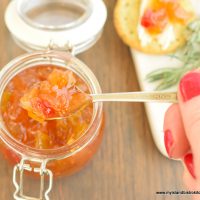
Green Tomato Marmalade
Ingredients
- 4 lbs green tomatoes
- 2½ lbs granulated sugar
- 1½ lemons, chopped + zest of lemons
- 1 orange, chopped + zest of orange
- 10 oz canned crushed pineapple
- 2" piece of cinnamon stick
- 4 oz drained maraschino cherries, chopped (optional)
Instructions
- Wash canning jars and lids in hot soapy water. Rinse. Drain jars.
- Wash tomatoes. Cut into sections and remove the stem end, core, seeds, and the watery/gelatinous sack around the seeds. Dice, or cut, the tomato pieces into small pieces (should equal apx. 9½ – 10 cups cut up). Place in large bowl and add the sugar. Let stand for three (3) hours to draw the juice from the tomatoes and allow the sugar to dissolve. Stir two to three times.
- Wash the lemons and orange well. Zest the lemons and oranges. Remove any seeds and cut lemons and orange into small pieces. Set aside.
- Using a slotted spoon, scoop out the crushed pineapple from the can. There is no need to thoroughly drain the pineapple in a sieve or colander but let most of the juice drip off the spoon for a few seconds before weighing out the 10oz of pineapple. There will still be some juice in the pineapple and up to a couple of tablespoons (no more) of the juice will be fine. Any more, however, and it would add too much liquid to the marmalade content, potentially causing issues getting it to set. Don’t be tempted to add any more than the 10 oz of crushed pineapple (with a bit of its juice) as, again, it may cause issues with the marmalade setting. Set weighed crushed pineapple aside.
- Fill a large-sized stockpot about two-thirds full of hot tap water. Fit stockpot with wire rack. Place the jars, on the rack, upright and in single layer, into the water. Use more than one stockpot if necessary to accommodate all jars needed for the recipe. Do not stack jars on top of each other in stockpot. Ensure the jars are fully submerged, each jar filled with water, and that the water is at least an inch over the tops of the jars, adding more if necessary. Cover, bring to a boil over medium-high heat, then reduce heat slightly and boil gently for 10 minutes. Turn off heat and leave the jars, covered, in the hot water to have ready to fill once the marmalade is ready.
- While the jars are sterilizing, transfer tomato–sugar mixture and the liquid to a medium-sized stock pot. Add the chopped lemons and orange and the zest, along with the crushed pineapple. Add the piece of cinnamon stick. Stir and bring to a boil over medium high heat, stirring frequently to prevent scorching. Immediately reduce heat and cook, uncovered, at a slow gentle boil until mixture thickens and reaches a temperature of 217°F - 220°F on a candy or instant read thermometer (see Note below for alternative method for testing marmalade doneness). Stir mixture frequently to prevent scorching. Remove and discard the cinnamon stick after about one hour, or slightly less, of cooking. Be patient, this cooking process can take awhile. Cooking the marmalade to a temperature of 220°F will yield a thicker marmalade but be slightly less pliable to spread than if it is cooked to 217°F.
- After the marmalade has been cooking for about 20-30 minutes, fill the canner about one-third to one-half full of hot tap water. Cover and bring to a boil to have it ready for the filled jars. Reduce heat to keep the canner water very hot.
- When the marmalade has reached its temperature, remove from heat and stir in the maraschino cherries, if using.
- Boil a kettle of water to have ready, if needed, to top up water levels in the canner once the filled jars are added.
- Use jar lifter tongs to carefully remove the hot sterilized jars from the water, one at a time, emptying the water from the jars back into the pot. Drain jars well and place upright on heat-proof board. Do be very careful as this is scalding hot water.
- Using a ladle, or a heat-proof glass measuring cup, and a wide-mouthed canning funnel, fill the hot sterilized jars with the marmalade, leaving about ¼” headroom in each jar to allow for expansion during the hot water processing. Remove any trapped air bubbles in the jars with a chopstick or small heatproof spatula. Add more marmalade to jars, if necessary, to bring marmalade up to ¼“ from jar rims. Wipe the jar rims with a clean damp cloth to remove any stickiness that could prevent the lids from sealing properly to the jars.
- Center the lids on jars so the sealing compound on the lid edges aligns with the jar rims. Fingertip tighten the ring/screw bands until resistance is encountered. Do not over-tighten.
- Using jar lifter tongs, carefully place hot filled jars upright in wire basket positioned in the canner, ensuring jars do not touch each other or fall over. If a canner is not completely full of filled jars, add enough hot empty jars to fill it to capacity to prevent filled jars from toppling over during processing. Make sure the empty jars are already hot as cold jars immersed in boiling hot water are likely to crack. Let the empty jars fill with water from the canner as they are submerged.
- Ensure the water level is at least 1” above the tops of jars, adding more boiling water as necessary. Cover with canner lid. Increase the heat to return the water to a full rolling boil then decrease the heat to just keep the water at a moderately rolling boil but not boiling over. Process jars in the hot water bath for 10 minutes, adjusting time as and if necessary for altitude. Start timing the processing from the point at which a full rolling boil is reached after jars have been added to the canner. At the end of the processing time, turn off heat and remove canner lid.
- Let jars sit in the hot water for 5 minutes then, using jar lifter tongs, carefully remove the jars filled with marmalade, one at a time, upright, and transfer them to a heat-proof cutting board, that has been covered with a towel, to cool completely. Listen for the “pop” or “ping” sound as the bottles seal over the next few minutes or hours. The lids of properly sealed jars will curve downward.
- Cover jars with a towel to keep light out and let jars rest, undisturbed, on counter for 24 hours. Then, test each jar for proper sealing by lightly pressing down on the center of each jar lid. If the lid is already pressed downward, and does not pop back up, it is properly sealed. Any jars that do not pass this test should be refrigerated and the marmalade used within a week or so.
- Store properly sealed marmalade bottles in cool, dark place and allow to rest for at least 1-2 weeks to allow flavor to fully develop before opening. Use marmalade within 1 year of bottling. Refrigerate marmalade once jar has been opened.
Recipe Notes
Yield: Apx. 6 half-pints
*Note that it is difficult to give a precise cooking time for the marmalade since various factors, including the quality of tomatoes and the heat level of the stove, can vary significantly and may affect cooking and marmalade-setting times. If you don’t have a candy thermometer or instant read thermometer to check doneness of marmalade at 217°F-220°F, place 2-3 freezer-proof saucers in the freezer when beginning to cook the marmalade. To test for doneness, place a small amount of marmalade on chilled saucer and swirl saucer around. Let marmalade sit, untouched, for about a minute, then gently push your finger through the marmalade. If the marmalade holds its shape (i.e., does not run back together after the finger has been removed from the marmalade), it is set and ready to bottle. If not, continue to cook mixture, repeating the “chill” test about every 3 minutes or so (always removing the pot from the heat while conducting the chill test) until the marmalade passes the “chill” test. Do not overcook as it will result in a very thick marmalade.
It is recommended that the first “chill” test be conducted somewhere around the 45-50 minute point in the cooking process. It does not necessarily mean that the marmalade will be done in that timeframe and more than one “chill” test may need to be performed.
[Copyright My Island Bistro Kitchen]
For more great marmalade recipes from My Island Bistro Kitchen, click on the links below:
Peach Marmalade
Rhubarb Marmalade
Pin Me To Pinterest!
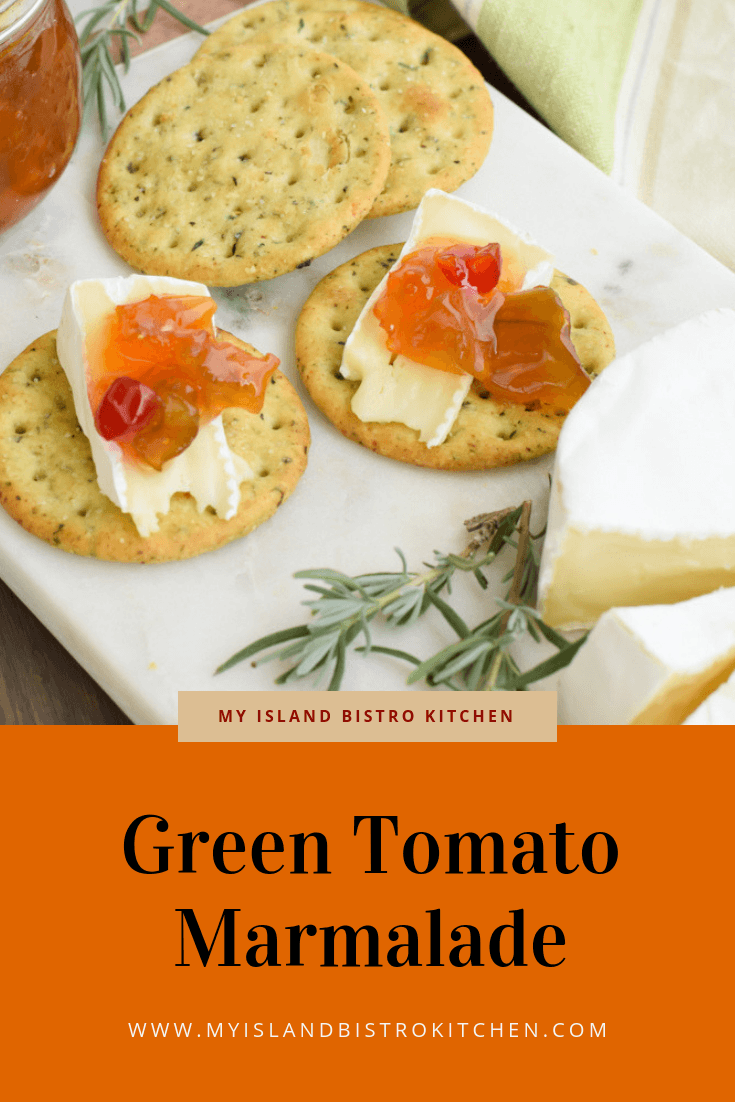
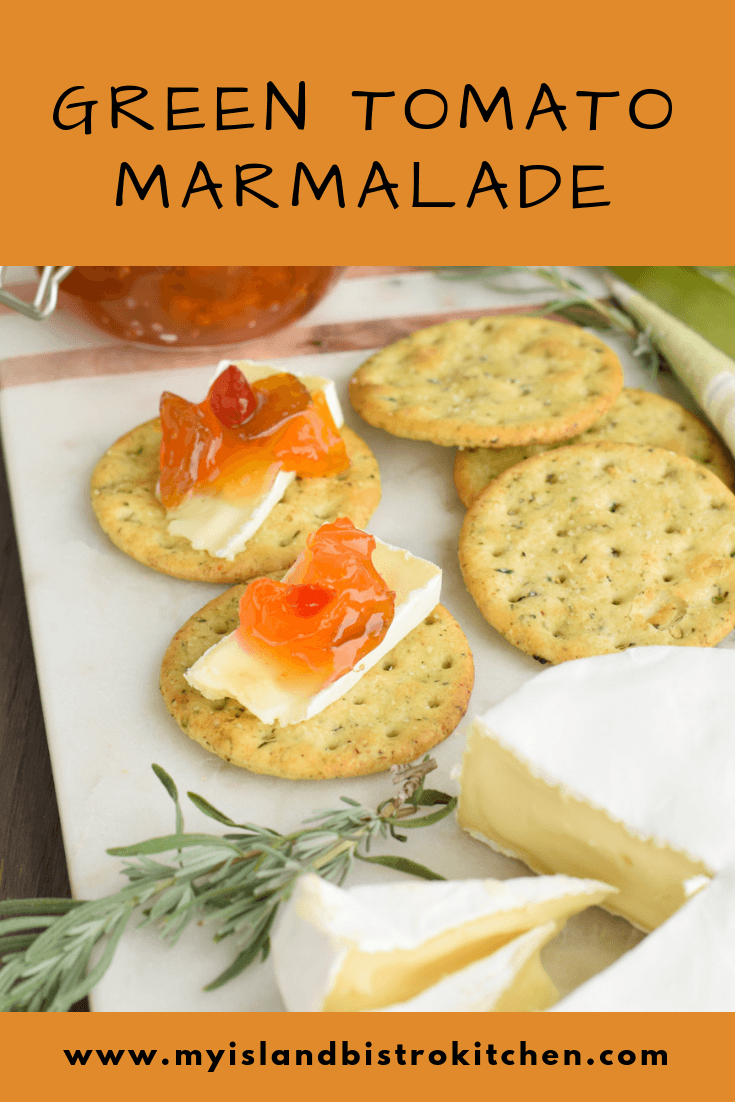
[This post and recipe were last updated on September 24, 2024]


